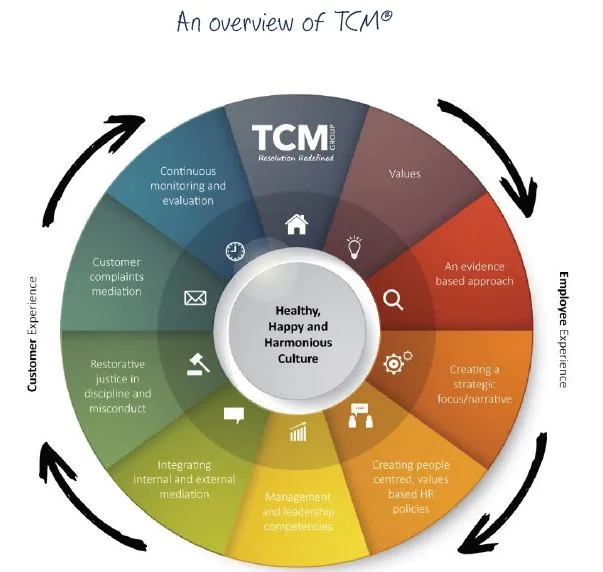Total Conflict Management or TCM® is a hybrid of Total Quality Management (TQM) and Integrated Conflict Management Systems (ICMS).
The objective of TCM® is to embed collaborative, constructive and compassionate problem solving at a systemic level within organisations. It is about promoting quality conversations and reducing the negative impact of dysfunctional conflicts. TCM® goes far beyond simply mediating in disputes. TCM® underpins leadership, management and human resources. TCM® transforms dysfunctional conflicts into positive dialogue which can underpin growth, add value and drive competitive advantage.
Organisations including Tesco, Royal Mail, Aviva, HSBC, TSB, BA, Virgin Atlantic, Lloyds Bank, DWP, Capgemini, Network Rail, London Ambulance Service, The Metropolitan Police, Transport for London, HMRC and numerous NHS Trust, councils, universities and police forces have adopted the TCM® System. The benefits that unify these many and varied organisations is that they are now reporting a happier, healthier and more harmonious workplace.
“Modern HR and employee relations should be moving towards thinking about the root causes of issues; identifying what steps can be done to prevent conflicts; and helping our managers to deal with issues at a much earlier stage.” Pete Hodgson, Head of Employee Relations at Tesco.
It all starts with the organisations values. The values are a golden thread upon which every other part of the TCM® system is attached. TCM® transforms values from nice words on a lobby wall into a living, breathing and very real part of employee and customer experience.

Organisations adopting the TCM® System gather quantitative and qualitative data as evidence to underpin their transformation. The data is then used to target resources and to engage a wide range of stakeholders into the design of the TCM® System.
Unresolved conflict presents a significant strategic risk to any business: money, time, productivity, reputation and competitive advantage. In my new book, Managing Conflict (Kogan Page/ CIPD), I identified a lack of a conflict management strategy as the number one cause of dysfunctional conflict. Boards require clearly presented facts and evidence to help them make their strategic decisions.
The traditional suite of HR rules and policies are problematic when it comes to managing conflict. I will focus on the grievance, bullying and harassment procedures. I call these the GBH procedures because much like a drunken brawl in a town centre on a Friday night, these procedures do commit Grievous Bodily Harm on our employees. In fact, they are worse, because the GBH procedures pretend to be caring, supportive and compassionate. The reality is that the GBH procedures are pernicious, divisive and damaging. They perpetuate a blame and claim culture. GBH procedures reinforce the victim/offender paradigm, are reductive and they infantilise the workforce. There can only be one winner from such an approach – and it’s not the business nor its people. Organisations are increasingly rejecting the tired GBH procedures in favour or a single Resolution Policy, and so could you.
TCM® is about aligning the behaviours of leaders and managers with the values of the organisation. Emotional intelligence, principled negotiation, compassion, mentoring, coaching and of course conflict competence all feature in the TCM® management competency framework. This is not the soft option, these are tough management skills.
Mediation is a powerful way to resolve a dispute. In fact, mediation is the most effective of all of the dispute resolution systems. However, it is often underused and widely misunderstood. By integrating mediation as part of a wider TCM® System, organisations can make mediation mainstream and ensure that it is used proactively.
In some cases of harassment or discrimination, it is preferable to allow the parties to enter into dialogue as an alternative to a formal process or once formal processes have been concluded.
RJ is a truly inspiring method for allowing the 2 parties to examine the nature of the behaviour and its impact. It gives a voice to the complainant and allows the subject to understand the impact of their behaviour directly form the person affected. RJ is similar to mediation but is undertaken by specially trained facilitators.
More and more organisations are placing open and transparent dialogue at the heart of their customer experience strategy. Mediation plays a pivotal part in achieving this. For instance, HMRC have adopted mediation to tackle tax disputes and many NHS trusts are embedding mediation as part of their patient complaints processes.
The TCM® System requires ongoing analysis and evaluation to ensure that it is working effectively and to assess its impact. Ongoing monitoring and evaluation also ensures that the cost benefit is being measured and can be reported to board and senior management teams.
Embedding a TCM® System is not for the faint of heart. If your organisation benefits from the status quo then it is not for you However, organisations including Aviva, Tesco and Royal Mail are recognising that a TCM® System is a powerful way of creating a happier, healthier and more harmonious workplace culture. Surely that’s got to be good for business.
David Liddle is CEO of The TCM Group and is author is a ground breaking new text Managing Conflict published by Kogan Page/ CIPD (2017)

Lorem ipsum dolor sit amet, consectetur adipiscing elit, sed do eiusmod tempor incididunt ut labore et dolore magna aliqua. Ut enim ad minim veniam, quis nostrud exercitation ullamco laboris nisi ut aliquip ex ea commodo consequat. Duis aute irure dolor in reprehenderit in voluptate velit esse cillum dolore eu fugiat nulla pariatur.
Block quote
Ordered list
Unordered list
Bold text
Emphasis
Superscript
Subscript